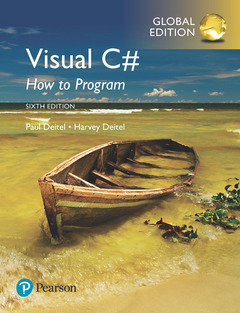Visual C# How to Program, Global Edition (6th Ed.)
Auteurs : Deitel Harvey, Deitel Paul

For all basic-to-intermediate level courses in Visual C# programming.
An informative, engaging, challenging and entertaining introduction to Visual C#
Created by world-renowned programming instructors Paul and Harvey Deitel, Visual C# How to Program, 6th Edition introduces students to the world of desktop, mobile and web app development with Microsoft?s® Visual C#® programming language. Students will use the .NET platform and the Visual Studio® Integrated Development Environment to write, test, and debug applications and run them on a wide variety of Windows® devices.
At the heart of the book is the Deitel signature live-code approach?rather than using code snippets, the authors present concepts in the context of complete working programs followed by sample executions. Students begin by getting comfortable with the Visual Studio Community edition IDE and basic C# syntax. Next, they build their skills one step at a time, mastering control structures, classes, objects, methods, variables, arrays, and the core techniques of object-oriented programming. With this strong foundation in place, the authors introduce more sophisticated techniques, including searching, sorting, data structures, generics, and collections. Additional practice is provided through a broad range of example programs and exercises selected from computer science, business, education, social issues, personal utilities, sports, mathematics, puzzles, simulation, game playing, graphics, multimedia and many other areas.
- 1. Introduction to Computers, the Internet and Visual C#
- 2. Introduction to Visual Studio and Visual Programming
- 3. Introduction to C# App Programming
- 4. Introduction to Classes, Objects, Methods and strings
- 5. Algorithm Development and Control Statements: Part 1
- 6. Control Statements: Part 2
- 7. Methods: A Deeper Look
- 8. Arrays; Introduction to Exception Handling
- 9. Introduction to LINQ and the List Collection
- 10. Classes and Objects: A Deeper Look
- 11. Object-Oriented Programming: Inheritance
- 12. OOP: Polymorphism and Interfaces
- 13. Exception Handling: A Deeper Look
- 14. Graphical User Interfaces with Windows Forms: Part 1
- 15. Graphical User Interfaces with Windows Forms: Part 2
- 16. Strings and Characters: A Deeper Look
- 17. Files and Streams
- 18. Searching and Sorting
- 19. Custom Linked Data Structures
- 20. Generics
- 21. Generic Collections; Functional Programming with LINQ/PLINQ
- 22. Databases and LINQ
- 23. Asynchronous Programming with async and await
- Appendices
- A Operator Precedence Chart
- B Simple Types
- C ASCII Character Set
- INDEX
Signature “Live Code™ Approach” — Language features are presented in the context of a wide variety of complete working programs.
· Features thousands of lines of code in hundreds of complete working programs.
· A broad range of example programs selected from computer science, business, simulation, game playing, graphics, multimedia and many other areas.
· Enables students to confirm that programs run as expected.
· Students can also download the code from the book's Companion Website www.pearsonglobaleditions.com/deitel.
Object-Oriented Programming
· Outstanding, consistent, and applied pedagogy. Icons throughout identify Software Engineering Observations; Good Programming Practices; Common Programming Errors; Portability Tips; Performance Tips; Testing and Debugging Tips; and Look-and-Feel Observations.
· Early-objects approach. The book introduces the basic concepts and terminology of object technology in Chapter 1. In Chapter 2, students will visually manipulate graphical user interface objects, such as labels and images. In Chapter 3, Introduction to C# App Programming, students will write Visual C# program code that manipulates preexisting objects. They will develop their first customized classes and objects in Chapter 4. Our early objects presentation continues in Chapters 5–9 with a variety of straightforward case studies. Chapters 10–12 take a deeper look at classes and objects.
· Rich coverage of programming fundamentals. Chapters 5 and 6 present a friendly treatment of control statements and problem solving.
· A clear, example-driven presentation of classes, objects, inheritance, polymorphism and interfaces.
· Optional case study: Using the UML to develop an object-oriented design and Visual C# im
Date de parution : 05-2017
Ouvrage de 1056 p.
17.9x23.3 cm
Disponible chez l'éditeur (délai d'approvisionnement : 14 jours).
Prix indicatif 80,31 €
Ajouter au panier


